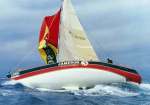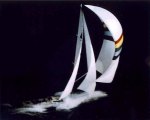Those of you who know me know I like to race sailboats, but I’m not a “one design” kind of guy (where absolutely identical boats with identical sails & identical crew weights race together) because I don’t get to use any ingenuity, creativity or technology. The problem is, outside one-design racing, yacht racing has failed. I’m also a VC and love to figure out how new technologies can help solve complex problems. So here goes…
“Development-class” yacht racing holds great conceptual appeal for owners who want to tweak their own boats, yet these formerly large race boat populations have collapsed due to increasingly-rapid failure of rating rules. (i.e. handicap systems where similar but non-identical boats race together.) Over the past 80 years, each rule has lasted half as long as its predecessor – usually due to slow and / or dangerous boats, unmanageable costs and sometimes boats that are hopelessly uncompetitive even before they hit the water.
Inception: Rule: Duration
1930: CCA/RORC: 40 years
1970: IOR: 20 years
1990: IMS (VPP): 10 years
2000: IRC/ORC (VPP): 5 years
HPR: ??
As a result, development-class boat numbers have collapsed worldwide from Cowes Week to the Giraglia Cup or Key West Race Week, while there is a boom in One Design fleets. (Key West now offers only one-design and PHRF)
What happened here? (Moore’s Law backwards.)
This disaster is is the opposite of Moore’s Law of semiconductors where electronics performance doubles approximately every 18 months creating huge new markets, so the result should be no surprise.
The CCA and RORC racing rules were established in the 1930s and produced excellent racing & great boats through the 1960s. However it failed to evolve to new high-performance materials such as fiberglass hulls, aluminum masts and dacron sails. (40 years.)
The International Offshore Rule (IOR) was therefore introduced in 1970 and produced heavy and slow boats (how fun is that?) until Sparkman & Stephens figured out how to game the rule leading to “dangerously unmanageable boats” (S&S own words) downwind due to the exaggerated mid-boat beam and pinched-in sterns the rule favored. IOR was modified numerous times resulting in boats becoming worthless in one year giving IOR its infamous nickname: “Invest Or Retire.” IOR was all but dead by 1990. (20 years)
Meanwhile the Wizard of Santa Cruz (Bill Lee) and others were building planing “ultralights” like Merlin in the late 1970s and obliterating distance records like the Transpac by days. As Bill Lee famously said, “fast is fun” but this fun would have to wait more than a decade because worldwide racing remained dominated by old-fashioned “leadmine” oriented rules.
IOR was replaced in the mid 1990s by International Measurement System (IMS), the first “black box” computer velocity-prediction program (VPP) rule where a secret (and evolving!) mathematical formula determined your rating. Designers guessed at the optima and this produced some excellent all-around boats until Farr + Beneteau figured out the combination of high-freeboard + light keels were the way to game this design resulting in the popular Beneteau First 40.7 aptly nicknamed the Beachball. Subsequently designers Botin-Carkeek extended that trend by ballast out of the keel and putting it in the bilge (reducing stability / safety and increasing weight) producing winning but slower and less safe boats. That was the beginning of the end of IMS. (10 years)
Similarly secret VPP-based rules named IRC and ORC (and the failed ORR) replaced IMS in 2008. These fixed some aspects of IMS producing both fast and fun boats, however the opacity of the rule resulted in limited adoption. Anyone who purchased an IRC boat before Juan K. figured out that hard chines & twin rudders are the way to game this rule, had a suddenly worthless boat. No surprise IRC is nearly moribund outside the UK.
Less than five years after IRC was founded, people realized these opaque rules are conceptual failures. The optimistically named High Performance Rule (HPR – based on the successful TransPac 52 design principles) is a far better-in-principle rule with published and calculable specs. but few are biting perhaps for a combination of expensive exotic-material & uncompromising pure-race boats only (i.e. no interiors) plus “rule fatigue.”
The exception is the evergreen Performance Handicapping Racing Fleet (PHRF – 1976) rule which allows handicapping across diverse fleets, as determined by the experience (and sometimes politics) of the local yacht racing authorities (YRA). However, because of variabilities in locally prevailing winds and depths, PHRF ratings are local only. (e.g. Los Angeles will not let you race with a San Francisco PHRF rating & vice versa.) So unfortunately, PHRF does not scale.
With this history of declining adoption and litter of worthless boats, it is no surprise that new boat growth is in one-design classes from J/Boats, Melges, Open Sailing and others.
Yet there remains an undeniably exciting aspect of development-class racing where owners, crews, designers and builders participate in the development and evolution of their yachts.
Can crowdsourcing help yacht racing?
The roots of all these failures are that they are defined by a handful of mostly wise old guys at influential but cozy yacht clubs like the RORC or CCA who decide what is good for those of us who actually race. To be fair, the CCA and RORC (and others) were instrumental in establishing the concept of rating rules and safety regs. but we have “been there, done that” too many times now.
So the question is how to define a new box rule with unprecedented input from owners, sailors and race managers? I suggest crowd-sourcing + expert guidance (to ensure things don’t get too dangerous through either extreme designs or construction) is the the only way. There is precedent! One crowd-sourced design / build has already occurred: Sailing-Anarchy’s forums defining of the “Anarchy 30” in 2002 became the Flying Tiger 10 meter boat with Bob Perry’s experienced design work. Over 100 have been built.
Online tools such as Poll Daddy can be used to determine preferences. Community participation levels can result in higher “ranking” in inputs. Participants can vote for “experts.”
So where to start?
I suggest a simple box-rule (e.g. boats must fit inside a dimensioned “box” that defines maximum length, beam, draft & air-draft) with several defined lengths that race in Level Classes (8 meters, 10, 12, 15, and 18 meters) with Cruiser, Cruiser-Racer (CR), Sport, and Grand-Prix divisions (permitting less or more use of exotic materials & professional crew) that allows participation by various price & performance points. Safety and build-standards are the size-applicable CE / ISO 12215 standards to ensure boats are stable, safe and strong.
Popular features such as non-overlapping headsails (as demonstrated by the wildly successful Farr 40) and bowsprits (vs. conventional poles) reduce crew size and expense. Construction material limits and annual sail limits help manage costs and are adjusted upwards as one evolves from Cruiser-Racer (CR) to Sport to Grand Prix levels.
I call this the Simple Fast Rule or SFR©. Conceptually it looks like this.
| Boat | L.O.A. | Safety / CE | Cruiser | C / R | Sport | Grand Prix |
| SFR 26 | 7.9M | B4/C5/D6 | X | X | ||
| SFR 33 | 9.90M | A8/B8/C8/D10 | X | X | X | |
| SFR 40 | 11.90M | A12/B12/C12 | X | X | X | X |
| SFR 45 | 13M | A12/B12/C12 | X | X | X | X |
| SFR 50 | 14.90M | A12/B12/C14 | X | X | X | X |
The remaining question is who’s up for the challenge?






You must be logged in to post a comment.